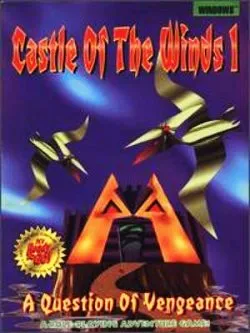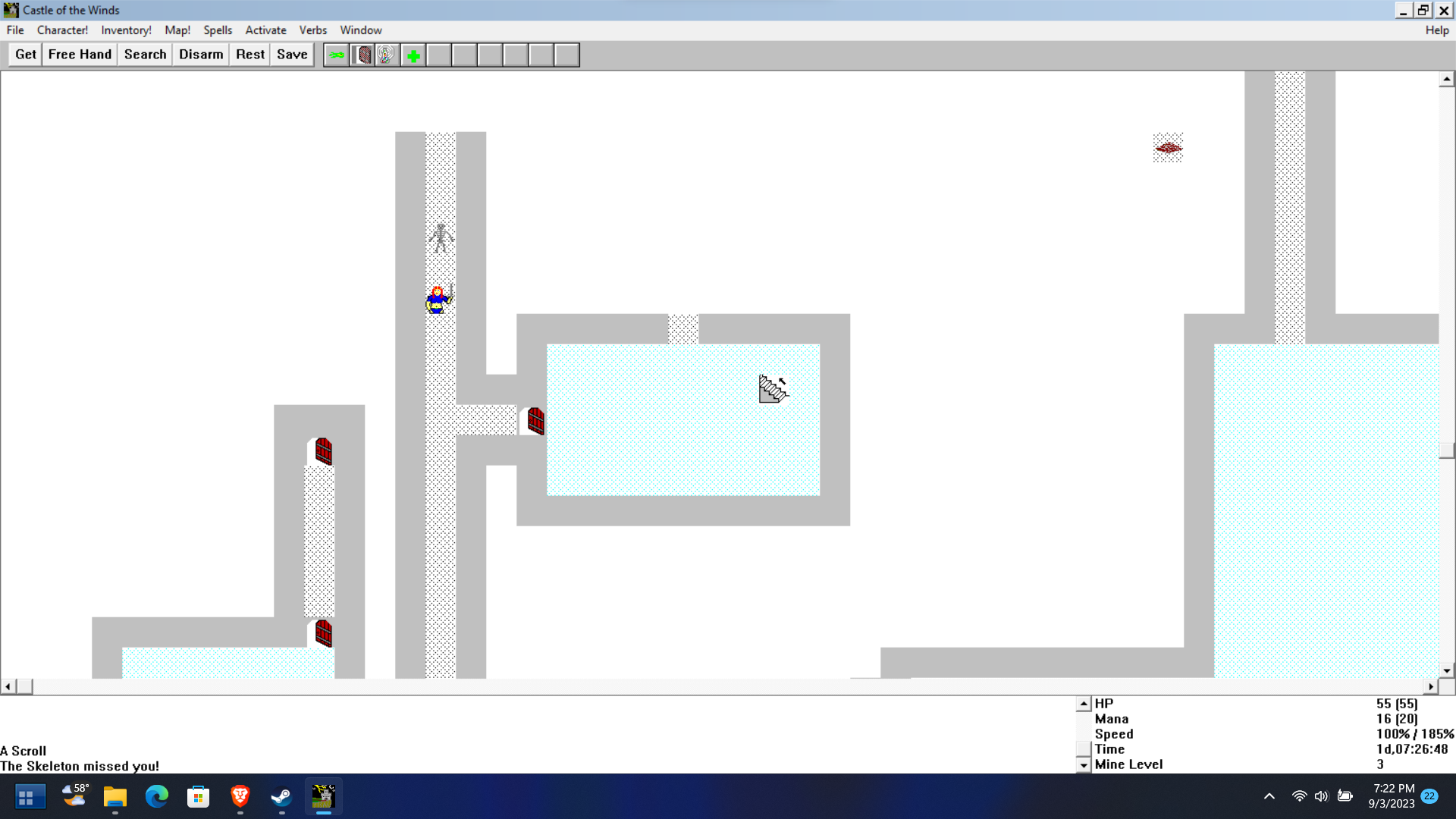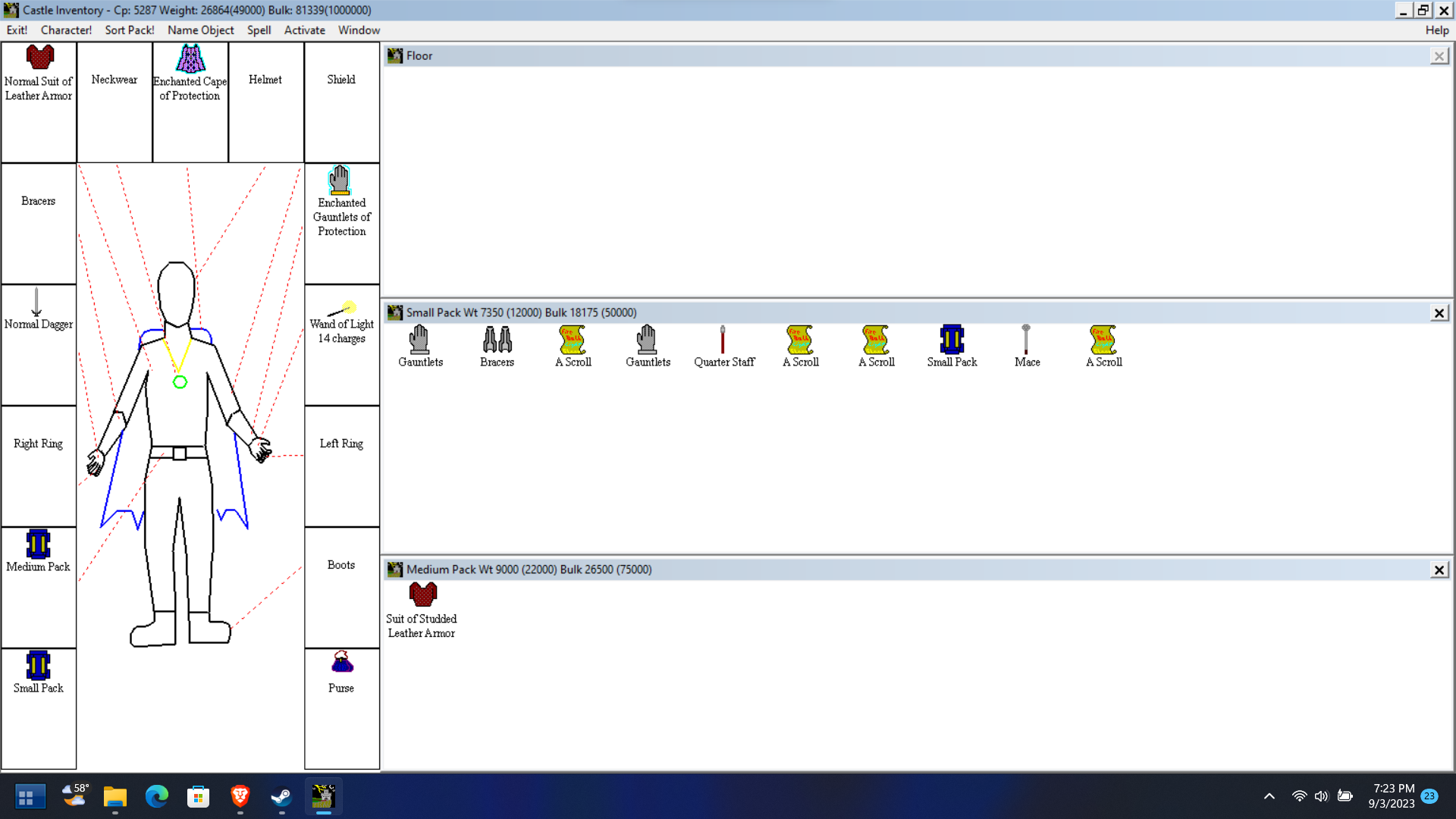Search
[{{{type}}}] {{{reason}}}
{{/data.error.root_cause}}{{{_source.title}}} {{#_source.showPrice}} {{{_source.displayPrice}}} {{/_source.showPrice}}
{{#_source.showLink}} {{/_source.showLink}} {{#_source.showDate}}{{{_source.displayDate}}}
{{/_source.showDate}}{{{_source.description}}}
{{#_source.additionalInfo}}{{#_source.additionalFields}} {{#title}} {{{label}}}: {{{title}}} {{/title}} {{/_source.additionalFields}}
{{/_source.additionalInfo}}- Details
- Category: Computer
- By Daniel Cullen
- Hits: 1697
Castle of the Winds

Castle of the Winds 1: A Question of Vengeance / Castle of the Winds 2: Lifthransir's Bane
Developed By: Rick Saada (SaadaSoft)
Published By: Epic Megagames
Released: 1993
Available On: Microsoft Windows
Genre: Rogue-like
ESRB Rating: none specified
Number of Players: Singleplayer
Price: Freeware
Note: Both parts of this game will be reviewed since they have the same engine and were only in two parts due to the first half being shareware. Second, while this generally does not run on modern 64-bit PCs, it is playable via various emulation methods. This review is based on having played this on both period-accurate hardware and emulation, more on that in the stability section of the review. The ideal method for 64-bit PCs is otvdm/winevdm, which I have also reviewed prior on CCG. Rick Saada made this absolute freeware in 1998, so it can be derived from a wide variety of places all over the internet with no legal problems.
Way back in the 1980s, when personal computers were nigh unicorns, a game called Rogue became a hit. Featuring ASCII text graphics, lots of text, and keyboard controls, it pioneered a genre of randomized dungeons and exploration and combat. All games like it since have become known as Rogue-likes. Castle of the Winds is a particularly beloved example from the early 90's for Windows that still holds up today.
Written by Rick Saada and later published by Epic Megagames in two parts, it uses a mix of elements from Norse myth and Dungeons & Dragons-style monsters to tell the story of an adopted child who discovers his adoptive parents murdered one day, apparently because of his real father's legacy. In Part 1, he seeks the killer of his adoptive parents. In Part 2, having discovered the birthplace of his real father, he becomes embroiled in an even greater adventure to defeat one of the greatest demons ever and reclaim his family's birthright.
The basic plot and gameplay structure are right out of the role-playing handbook. Starting in a town not far from his family home, the player character purchases supplies before investigating a nearby dungeon for clues about his parent's killer. This pattern continues as the player moves between towns and dungeons till they reach their goals. In the dungeons, whose floors are never the same each save file, must fight off monsters, avoid traps, and find stairs to continue progress until they reach their goals at the bottom. The basic gameplay loop remains the same, but the randomized nature means no games will ever be identical.

Strong Points: Simple yet fun rogue-like
Weak Points: Heavily mouse-driven and hard to play without one
Moral Warnings: RPG-style violence; some sparse mentions of Hell in the religious sense; frank textual descriptions of gore and blood; heavy references to Norse myth and usage of necromancy including by player to some extent if they choose; possibility to accidentally kill a civilian
Graphically, this is a very simple game. Using around 16 colors (it was designed to support monochrome setups as well), this game manages to make some simple yet eye-catching top-down environments, especially in the towns where all the art is explicitly hand-drawn. Dungeons use a randomized design (set in place when you change floors only, so you can save before changing floors and get a different design each time) with gray walls and semi-transparent white mesh to represent floors. Lighted rooms are shown with the mesh being shaded in light blue. All other art is essentially a series of icons (including the character of the player, who can be replaced by any file in .ico format they choose if they wish). Given the era and simplicity, it works. Some of the fancier spell effects are vividly drawn, like the "Fire/Cold/Thunder Ball" spells, so they look good despite very simple animation.
This game has no sounds or music whatsoever. Being based on the roguelikes of old hailing back to the DOS era, this is not a surprise, but that doesn't count against the game in any way.
The game is primarily controlled by the mouse and keyboard, especially the former. It's also quite menu-driven, so expect to use the "Verbs" menu quite a bit to restore mana often. It's technically possible to use the keyboard alone, but given how much of a pain diagonal movement is in the dungeons, a mouse is going to be the preferred option.
Game stability is not an issue. Aside from a few math overflow bugs (though these can work in the player's favor if they know the conditions), this title is pretty stable. The issue comes from how to run it. On any 16 or 32-bit Windows (Windows 3.0/3.1/95/98/ME/2000/XP/Vista/7/8/10), this will run natively. It will run with little issue via Wine on all versions of Linux. It should run on Steam Deck via the same methods, but control will require a mouse of some sort since it was heavily mouse-driven (the touchpad can work but accuracy can vary). On 64-bit versions of Windows, a sandboxed emulation of 16/32 bit Windows (in Dosbox or some other virtualization environment) is recommended, though a simpler method is the use of otvdm/winevdm, which emulates the 16-bit game engine which, on runtime, 32-bit call equivalents run seamlessly (I recommend this for least amount of setup needed). Many sites have embedded it for play in a web browser should one wish to play it that way.

Higher is better
(10/10 is perfect)
Game Score - 84%
Gameplay - 16/20
Graphics - 7/10
Sound - 10/10
Stability - 5/5
Controls - 4/5
Morality Score - 64%
Violence - 5/10
Language - 9/10
Sexual Content - 10/10
Occult/Supernatural - 0/10
Cultural/Moral/Ethical - 8/10
Morally, this has some definite issues.
Violence is RPG style "give orders and watch it happen" style. Given the art style, it's pretty sterile looking, with no enemy body parts left visually or blood after defeat. The descriptions of some of the enemy kills can get pretty graphic though, describing the gore in vivid levels of detail.
The language is pretty clean. Given the Old English text styling, what few written story sections exist are free of foul language by any contemporary standard. Hell is mentioned in the bestiary in the religious sense when referring to demons and similar beings. Sexual commentary is also nil.
Given the game was a very old roguelike with the most rudimentary of graphics, there are no sexual depictions at all. On the other hand, the story is deeply steeped in Norse tradition and includes Temples of Odin instead of churches. Also, while Necromancers generally exist as enemies, the game does, albeit does not purposefully recommend, allow the player to use some cursed items that allow for summoning demons and the undead.
Morally and ethically, the player is hunting down those who murdered his family and generally do harm to others in the first half, and trying to put to rest of the soul of his departed father in the second half. Neither is objectionable, though it's worth noting it is possible to accidentally kill a defenseless civilian prisoner at one point in the second part due to potential friendly fire, albeit clearly accidental.
Given this game is free and easily playable on modern PCs via various means, it's a game well worth getting if you enjoy roguelikes. Morally, it has some issues, especially due to the Norse lore themes and necromancy references especially. Overall, I recommend getting it and playing it. Not the most advanced game by modern standards, but certainly entertaining for what it is regardless.








